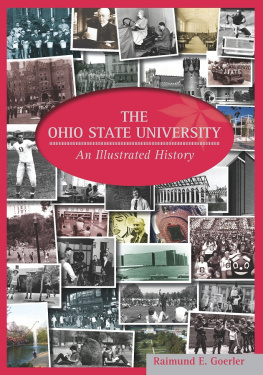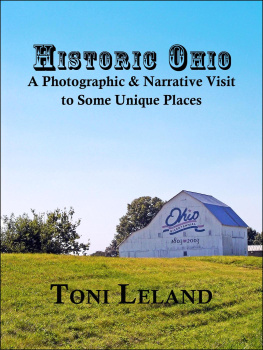Wild Ohio : the best of our natural heritage / Jim McCormac and Gary Meszaros.
p. cm.
Includes bibliographical references and index.
ISBN 978-0-87338-985-3 (alk. paper)
1. Natural historyOhioPictorial works.
2. Natural areasOhioPictorial works.
3. ParksOhioPictorial works.
4. Wildlife refugesOhioPictorial works.
5. Forest reservesOhioPictorial works.
6. OhioHistory, LocalPictorial works.
7. Natural historyOhio.
8. OhioHistory, Local.
9. OhioDescription and travel.
10. OhioEnvironmental conditions.
I. Meszaros, Gary. II. Title.
British Library Cataloging-in-Publication data are available.
I can think of few individuals in Ohio more qualified than Jim McCormac and Gary Meszaros to write and illustrate a book on the best remaining examples of the natural habitats that were present within Ohio a little more than 200 years ago.
Both Gary and Jim have devoted a significant portion of their professional and personal lives to exploring the most pristine remnants of our original forests, glacial lakes (including the largestLake Erie), vast marshes, swamps, bogs, fens, oak savannas, rock cliffs, and streams large and small throughout the state. Both have spent countless hours exploring rare habitats throughout Ohio that support the last-known occurrences of particular members of our states endangered flora and fauna. Their respective reputations for discovering new populations of rarities, both within and outside their respective areas of expertise, are legendary among professional biologists and the private and public managers of the extensive system of parks and nature preserves scattered across our state.
Pairing Jims encyclopedic knowledge of the natural communities in Ohios physiographic provinces with Garys photographic talent has produced a book for everyone who champions the protection of wild Ohio.
What conservationists now consider to be the most important and imperiled remnants of our natural heritage has changed dramatically since the Ohio Natural Heritage Program was established in 1980. This has been due in large part to the efforts of amateur and professional biologists who have discovered more than 100 new, ecologically significant natural areas and contributed thousands of records of new rare plant and animal occurrences in Ohio to the Natural Heritage Program and the Ohio Division of Wildlife. Several of the natural areas that Gary and Jim selected to feature in this book are among those new sites.
Interestingly, more than 170 plant species thought to be rare when the Ohio Natural Heritage Program was established have been removed from the Ohio Rare Plant List due to proof that they are, in fact, not rare. In some cases, this improved knowledge has helped us see that some habitats are much more common, while other habitats thought to be relatively secure are actually threatened.
The thousands of Ohio rare plant and animal occurrence records held, respectively, by the Ohio Natural Heritage Program and Ohio Division of Wildlife are used to determine which habitat types and specific geographic sites are most in need of protection. Efforts during the past few decades to improve our collective knowledge of the distribution and rarity of several biological groups, including moths, butterflies, mosses, lichens, dragonflies, caddis flies, fish, and freshwater mussels, have identified dozens of sites in the state as biologically important habitats that should be protected.
While it is important to continue supporting these efforts, we should also direct funds to help develop the expertise and field support for the study of other biological groups that are still frontiers in our knowledge base, such as ground beetles, grasshoppers, spider wasps, land snails, and mammals. We need to identify and protect the habitats in which these creatures occur before they are lost.
The future residents of Ohio will only be able to witness the outstanding examples of our natural heritage chosen for this book if its current residents devote more resources toward reducing and, ideally, stopping the spread of invasive plants and animals into our natural areas. Without proper management of our parks, wildlife preserves, private nature preserves, and conservation easements, most of the outstanding habitats featured in this book will be irreparably altered over the next fifty years.
The overpopulation of white-tailed deer and invasion of non-native earthworms are particular problems. These two creatures are producing biological deserts beneath many of our forest canopies. There is presently no known method to reverse this trend. Perhaps this book will inspire someone to devise a solution. Fortunately, state, federal, and local governmental agencies, nonprofit conservation organizations, and land trusts across Ohio are beginning to earmark funds for this sort of environmental stewardship.
Global climate change is the newest challenge to our protected lands. The projected warming of our climate will change the composition of dominant species on many of the nature preserves in the state. However, its important to remember the flexibility inherent in natural systems. If our protected lands receive proper environmental stewardship, most of the native habitats included in this book will still support outstanding biodiversity fifty years from now.
Its my hope that this book will move people to support the statewide effort to steward and protect the best remaining examples of Ohios natural heritage.
Dr. James K. Bissell
Director of Conservation
Curator of Botany
The Cleveland Museum of Natural History
W e hope this book never becomes an epitaph for what once was. Ohio is incredibly rich in biodiversity, possibly more so than any other midwestern state. But in the course of assembling a documentary book like this one, its impossible not to think about what weve lost. Some three hundred years ago the first European settlers stepped into the Ohio country, and its been nonstop development ever since.
Once, unchecked exploitation of our natural landscape was understandable, if not excusable. To the first pioneers, Ohio must have seemed like a land of inexhaustible bounty. But it isnt, and that fact has been indisputably driven home.
The Buckeye State has lost over 90 percent of its original wetlandssecond only to California amongst the fifty states. Wetlands (such as bogs, fens, and wet prairie) that are now great rarities once blanketed large expanses. Much of what is now Buckeye Lake in Licking County was a massive cranberry bog. The 427 acres of Cedar Bog are all that remain of an approximately seven-thousand-acre cedar fen. Grand Lake St. Marys in Auglaize and Mercer counties, the largest man-made lake in the world when it was built, flooded what must have been a spectacular wet prairie. The Great Black Swamp of northwest Ohio has been drained and cropped. Attendant with these losses has been a great diminishment of wetland flora and fauna.













